Impact of Communication Tools and Cloud Computing: Digital Age IPS
VerifiedAdded on 2022/11/25
|10
|3898
|81
Report
AI Summary
This report examines the significance of Information and Communication Technology (ICT) in the digital age, focusing on communication and collaboration tools like Slack, Zoom, Cisco WebEx, Microsoft Teams, G Suite, and Asana, especially during the pandemic. It details the impact of these tools on business operations, including real-time project tracking, task assignment, and cost efficiency. The report also discusses cloud computing and storage, outlining their advantages (cost savings, speed, data backup) and disadvantages (technical issues, security threats), along with their applications in online data storage, data research, and e-commerce. The study highlights how these technologies have reshaped business practices and enhanced organizational performance in the modern era.
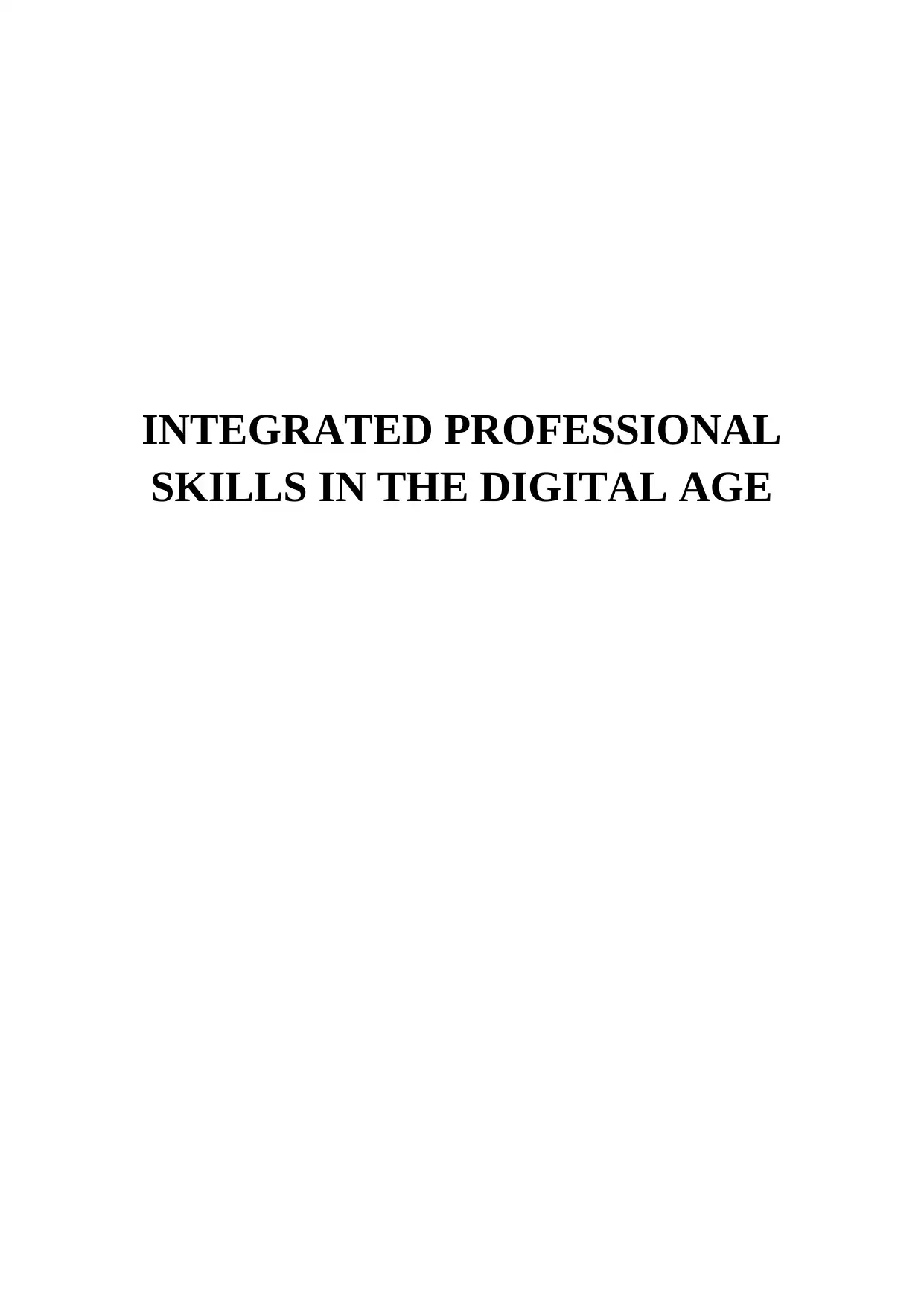
INTEGRATED PROFESSIONAL
SKILLS IN THE DIGITAL AGE
SKILLS IN THE DIGITAL AGE
Paraphrase This Document
Need a fresh take? Get an instant paraphrase of this document with our AI Paraphraser
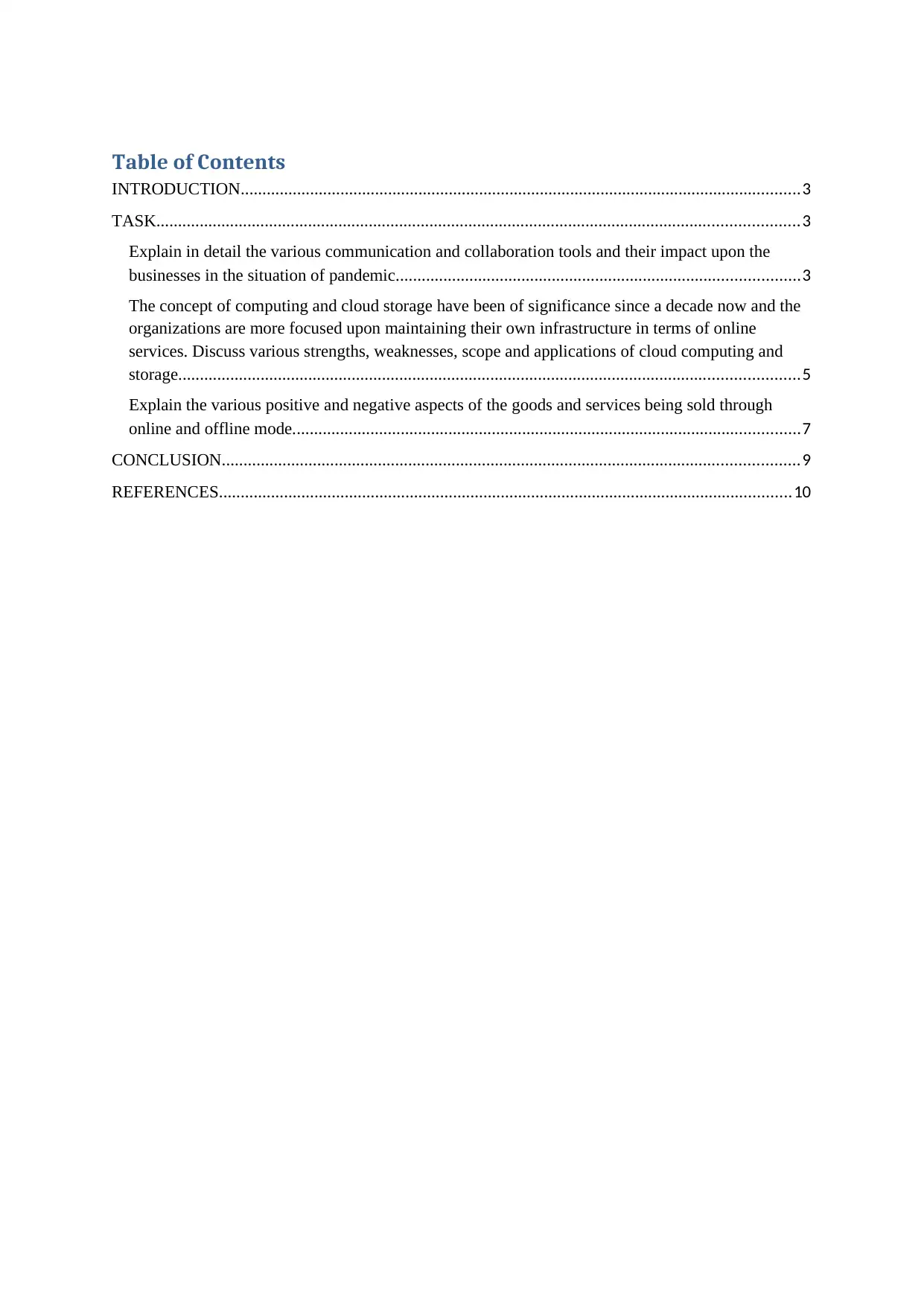
Table of Contents
INTRODUCTION.................................................................................................................................3
TASK....................................................................................................................................................3
Explain in detail the various communication and collaboration tools and their impact upon the
businesses in the situation of pandemic.............................................................................................3
The concept of computing and cloud storage have been of significance since a decade now and the
organizations are more focused upon maintaining their own infrastructure in terms of online
services. Discuss various strengths, weaknesses, scope and applications of cloud computing and
storage...............................................................................................................................................5
Explain the various positive and negative aspects of the goods and services being sold through
online and offline mode.....................................................................................................................7
CONCLUSION.....................................................................................................................................9
REFERENCES....................................................................................................................................10
INTRODUCTION.................................................................................................................................3
TASK....................................................................................................................................................3
Explain in detail the various communication and collaboration tools and their impact upon the
businesses in the situation of pandemic.............................................................................................3
The concept of computing and cloud storage have been of significance since a decade now and the
organizations are more focused upon maintaining their own infrastructure in terms of online
services. Discuss various strengths, weaknesses, scope and applications of cloud computing and
storage...............................................................................................................................................5
Explain the various positive and negative aspects of the goods and services being sold through
online and offline mode.....................................................................................................................7
CONCLUSION.....................................................................................................................................9
REFERENCES....................................................................................................................................10
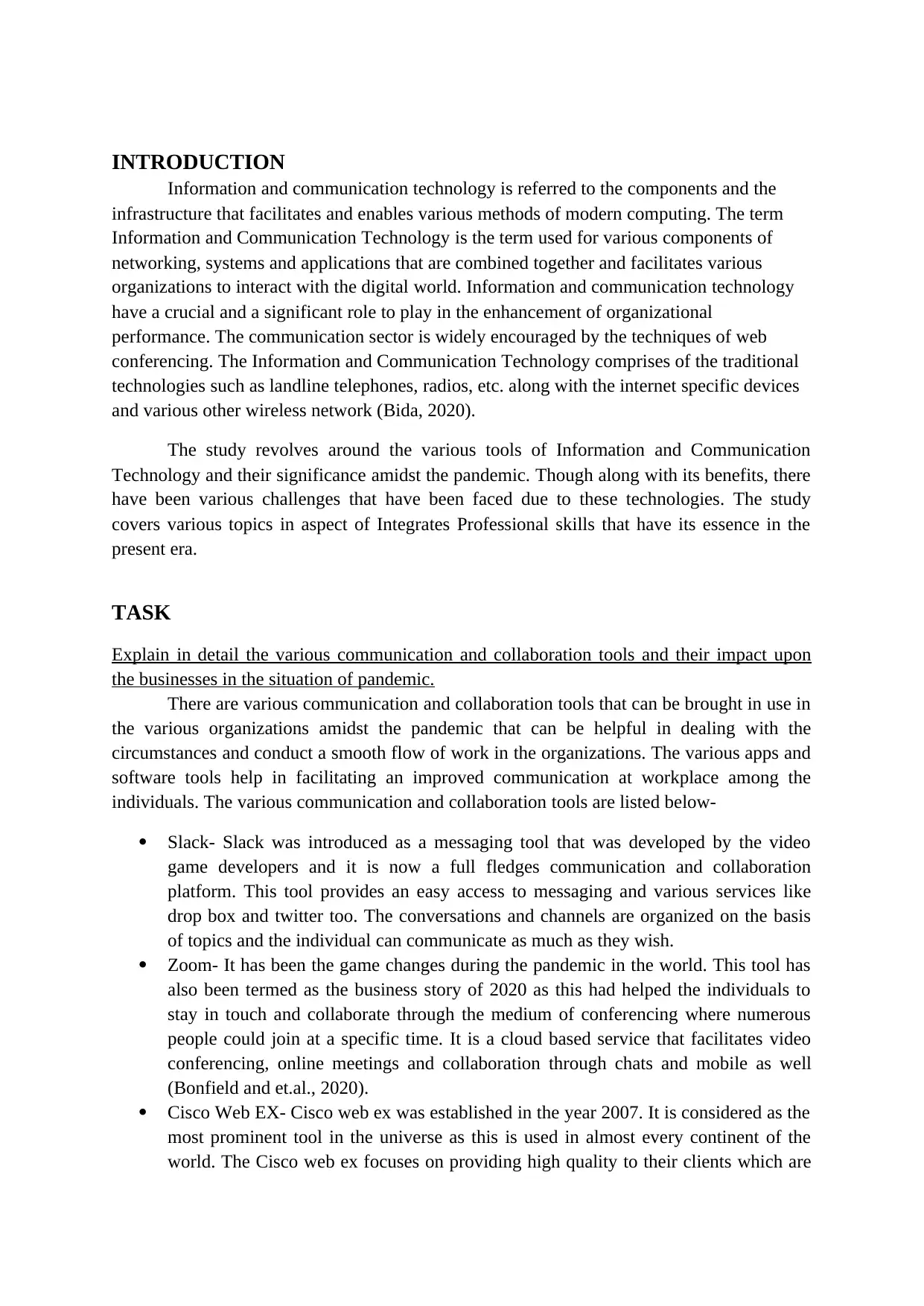
INTRODUCTION
Information and communication technology is referred to the components and the
infrastructure that facilitates and enables various methods of modern computing. The term
Information and Communication Technology is the term used for various components of
networking, systems and applications that are combined together and facilitates various
organizations to interact with the digital world. Information and communication technology
have a crucial and a significant role to play in the enhancement of organizational
performance. The communication sector is widely encouraged by the techniques of web
conferencing. The Information and Communication Technology comprises of the traditional
technologies such as landline telephones, radios, etc. along with the internet specific devices
and various other wireless network (Bida, 2020).
The study revolves around the various tools of Information and Communication
Technology and their significance amidst the pandemic. Though along with its benefits, there
have been various challenges that have been faced due to these technologies. The study
covers various topics in aspect of Integrates Professional skills that have its essence in the
present era.
TASK
Explain in detail the various communication and collaboration tools and their impact upon
the businesses in the situation of pandemic.
There are various communication and collaboration tools that can be brought in use in
the various organizations amidst the pandemic that can be helpful in dealing with the
circumstances and conduct a smooth flow of work in the organizations. The various apps and
software tools help in facilitating an improved communication at workplace among the
individuals. The various communication and collaboration tools are listed below-
Slack- Slack was introduced as a messaging tool that was developed by the video
game developers and it is now a full fledges communication and collaboration
platform. This tool provides an easy access to messaging and various services like
drop box and twitter too. The conversations and channels are organized on the basis
of topics and the individual can communicate as much as they wish.
Zoom- It has been the game changes during the pandemic in the world. This tool has
also been termed as the business story of 2020 as this had helped the individuals to
stay in touch and collaborate through the medium of conferencing where numerous
people could join at a specific time. It is a cloud based service that facilitates video
conferencing, online meetings and collaboration through chats and mobile as well
(Bonfield and et.al., 2020).
Cisco Web EX- Cisco web ex was established in the year 2007. It is considered as the
most prominent tool in the universe as this is used in almost every continent of the
world. The Cisco web ex focuses on providing high quality to their clients which are
Information and communication technology is referred to the components and the
infrastructure that facilitates and enables various methods of modern computing. The term
Information and Communication Technology is the term used for various components of
networking, systems and applications that are combined together and facilitates various
organizations to interact with the digital world. Information and communication technology
have a crucial and a significant role to play in the enhancement of organizational
performance. The communication sector is widely encouraged by the techniques of web
conferencing. The Information and Communication Technology comprises of the traditional
technologies such as landline telephones, radios, etc. along with the internet specific devices
and various other wireless network (Bida, 2020).
The study revolves around the various tools of Information and Communication
Technology and their significance amidst the pandemic. Though along with its benefits, there
have been various challenges that have been faced due to these technologies. The study
covers various topics in aspect of Integrates Professional skills that have its essence in the
present era.
TASK
Explain in detail the various communication and collaboration tools and their impact upon
the businesses in the situation of pandemic.
There are various communication and collaboration tools that can be brought in use in
the various organizations amidst the pandemic that can be helpful in dealing with the
circumstances and conduct a smooth flow of work in the organizations. The various apps and
software tools help in facilitating an improved communication at workplace among the
individuals. The various communication and collaboration tools are listed below-
Slack- Slack was introduced as a messaging tool that was developed by the video
game developers and it is now a full fledges communication and collaboration
platform. This tool provides an easy access to messaging and various services like
drop box and twitter too. The conversations and channels are organized on the basis
of topics and the individual can communicate as much as they wish.
Zoom- It has been the game changes during the pandemic in the world. This tool has
also been termed as the business story of 2020 as this had helped the individuals to
stay in touch and collaborate through the medium of conferencing where numerous
people could join at a specific time. It is a cloud based service that facilitates video
conferencing, online meetings and collaboration through chats and mobile as well
(Bonfield and et.al., 2020).
Cisco Web EX- Cisco web ex was established in the year 2007. It is considered as the
most prominent tool in the universe as this is used in almost every continent of the
world. The Cisco web ex focuses on providing high quality to their clients which are
⊘ This is a preview!⊘
Do you want full access?
Subscribe today to unlock all pages.

Trusted by 1+ million students worldwide
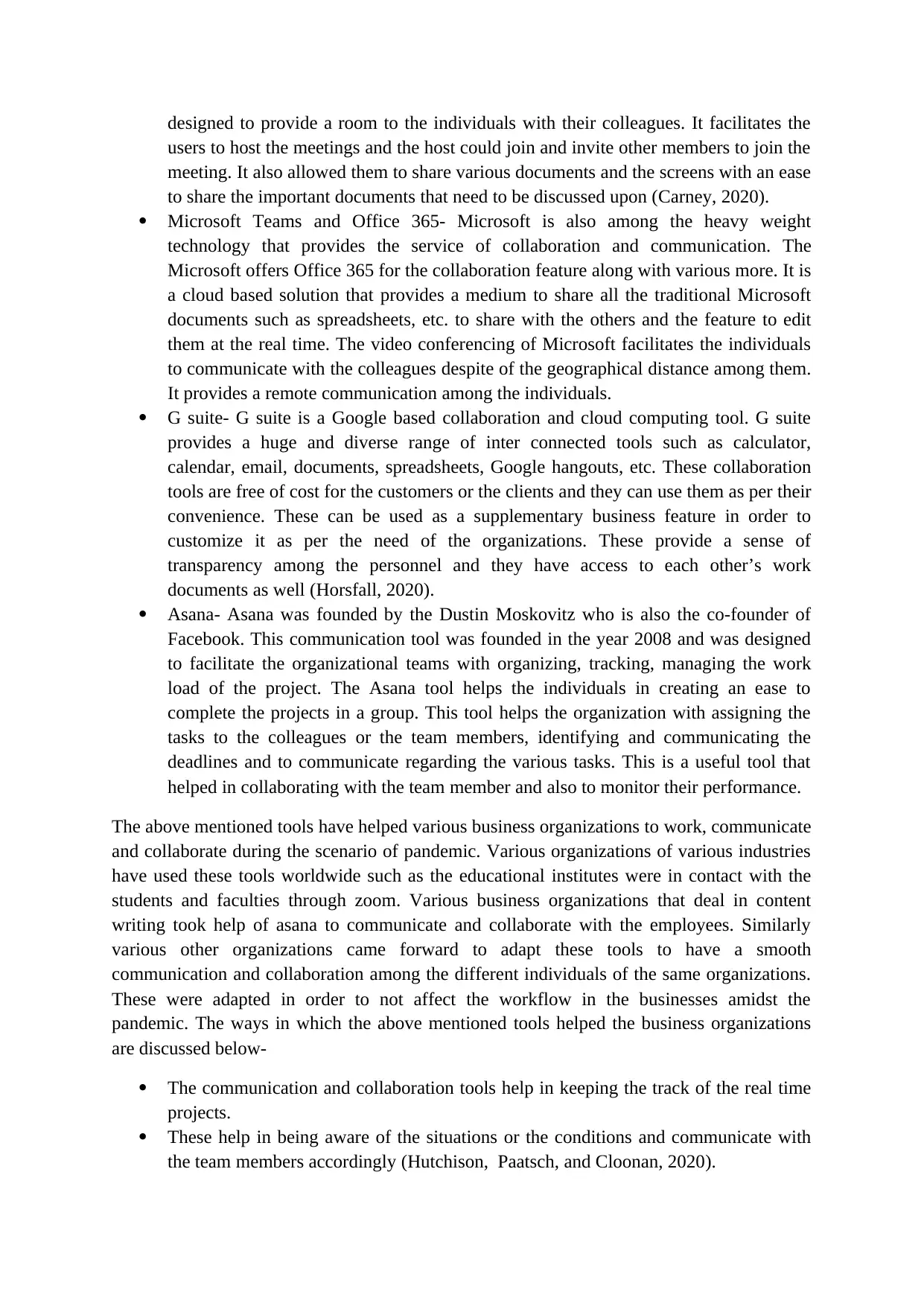
designed to provide a room to the individuals with their colleagues. It facilitates the
users to host the meetings and the host could join and invite other members to join the
meeting. It also allowed them to share various documents and the screens with an ease
to share the important documents that need to be discussed upon (Carney, 2020).
Microsoft Teams and Office 365- Microsoft is also among the heavy weight
technology that provides the service of collaboration and communication. The
Microsoft offers Office 365 for the collaboration feature along with various more. It is
a cloud based solution that provides a medium to share all the traditional Microsoft
documents such as spreadsheets, etc. to share with the others and the feature to edit
them at the real time. The video conferencing of Microsoft facilitates the individuals
to communicate with the colleagues despite of the geographical distance among them.
It provides a remote communication among the individuals.
G suite- G suite is a Google based collaboration and cloud computing tool. G suite
provides a huge and diverse range of inter connected tools such as calculator,
calendar, email, documents, spreadsheets, Google hangouts, etc. These collaboration
tools are free of cost for the customers or the clients and they can use them as per their
convenience. These can be used as a supplementary business feature in order to
customize it as per the need of the organizations. These provide a sense of
transparency among the personnel and they have access to each other’s work
documents as well (Horsfall, 2020).
Asana- Asana was founded by the Dustin Moskovitz who is also the co-founder of
Facebook. This communication tool was founded in the year 2008 and was designed
to facilitate the organizational teams with organizing, tracking, managing the work
load of the project. The Asana tool helps the individuals in creating an ease to
complete the projects in a group. This tool helps the organization with assigning the
tasks to the colleagues or the team members, identifying and communicating the
deadlines and to communicate regarding the various tasks. This is a useful tool that
helped in collaborating with the team member and also to monitor their performance.
The above mentioned tools have helped various business organizations to work, communicate
and collaborate during the scenario of pandemic. Various organizations of various industries
have used these tools worldwide such as the educational institutes were in contact with the
students and faculties through zoom. Various business organizations that deal in content
writing took help of asana to communicate and collaborate with the employees. Similarly
various other organizations came forward to adapt these tools to have a smooth
communication and collaboration among the different individuals of the same organizations.
These were adapted in order to not affect the workflow in the businesses amidst the
pandemic. The ways in which the above mentioned tools helped the business organizations
are discussed below-
The communication and collaboration tools help in keeping the track of the real time
projects.
These help in being aware of the situations or the conditions and communicate with
the team members accordingly (Hutchison, Paatsch, and Cloonan, 2020).
users to host the meetings and the host could join and invite other members to join the
meeting. It also allowed them to share various documents and the screens with an ease
to share the important documents that need to be discussed upon (Carney, 2020).
Microsoft Teams and Office 365- Microsoft is also among the heavy weight
technology that provides the service of collaboration and communication. The
Microsoft offers Office 365 for the collaboration feature along with various more. It is
a cloud based solution that provides a medium to share all the traditional Microsoft
documents such as spreadsheets, etc. to share with the others and the feature to edit
them at the real time. The video conferencing of Microsoft facilitates the individuals
to communicate with the colleagues despite of the geographical distance among them.
It provides a remote communication among the individuals.
G suite- G suite is a Google based collaboration and cloud computing tool. G suite
provides a huge and diverse range of inter connected tools such as calculator,
calendar, email, documents, spreadsheets, Google hangouts, etc. These collaboration
tools are free of cost for the customers or the clients and they can use them as per their
convenience. These can be used as a supplementary business feature in order to
customize it as per the need of the organizations. These provide a sense of
transparency among the personnel and they have access to each other’s work
documents as well (Horsfall, 2020).
Asana- Asana was founded by the Dustin Moskovitz who is also the co-founder of
Facebook. This communication tool was founded in the year 2008 and was designed
to facilitate the organizational teams with organizing, tracking, managing the work
load of the project. The Asana tool helps the individuals in creating an ease to
complete the projects in a group. This tool helps the organization with assigning the
tasks to the colleagues or the team members, identifying and communicating the
deadlines and to communicate regarding the various tasks. This is a useful tool that
helped in collaborating with the team member and also to monitor their performance.
The above mentioned tools have helped various business organizations to work, communicate
and collaborate during the scenario of pandemic. Various organizations of various industries
have used these tools worldwide such as the educational institutes were in contact with the
students and faculties through zoom. Various business organizations that deal in content
writing took help of asana to communicate and collaborate with the employees. Similarly
various other organizations came forward to adapt these tools to have a smooth
communication and collaboration among the different individuals of the same organizations.
These were adapted in order to not affect the workflow in the businesses amidst the
pandemic. The ways in which the above mentioned tools helped the business organizations
are discussed below-
The communication and collaboration tools help in keeping the track of the real time
projects.
These help in being aware of the situations or the conditions and communicate with
the team members accordingly (Hutchison, Paatsch, and Cloonan, 2020).
Paraphrase This Document
Need a fresh take? Get an instant paraphrase of this document with our AI Paraphraser
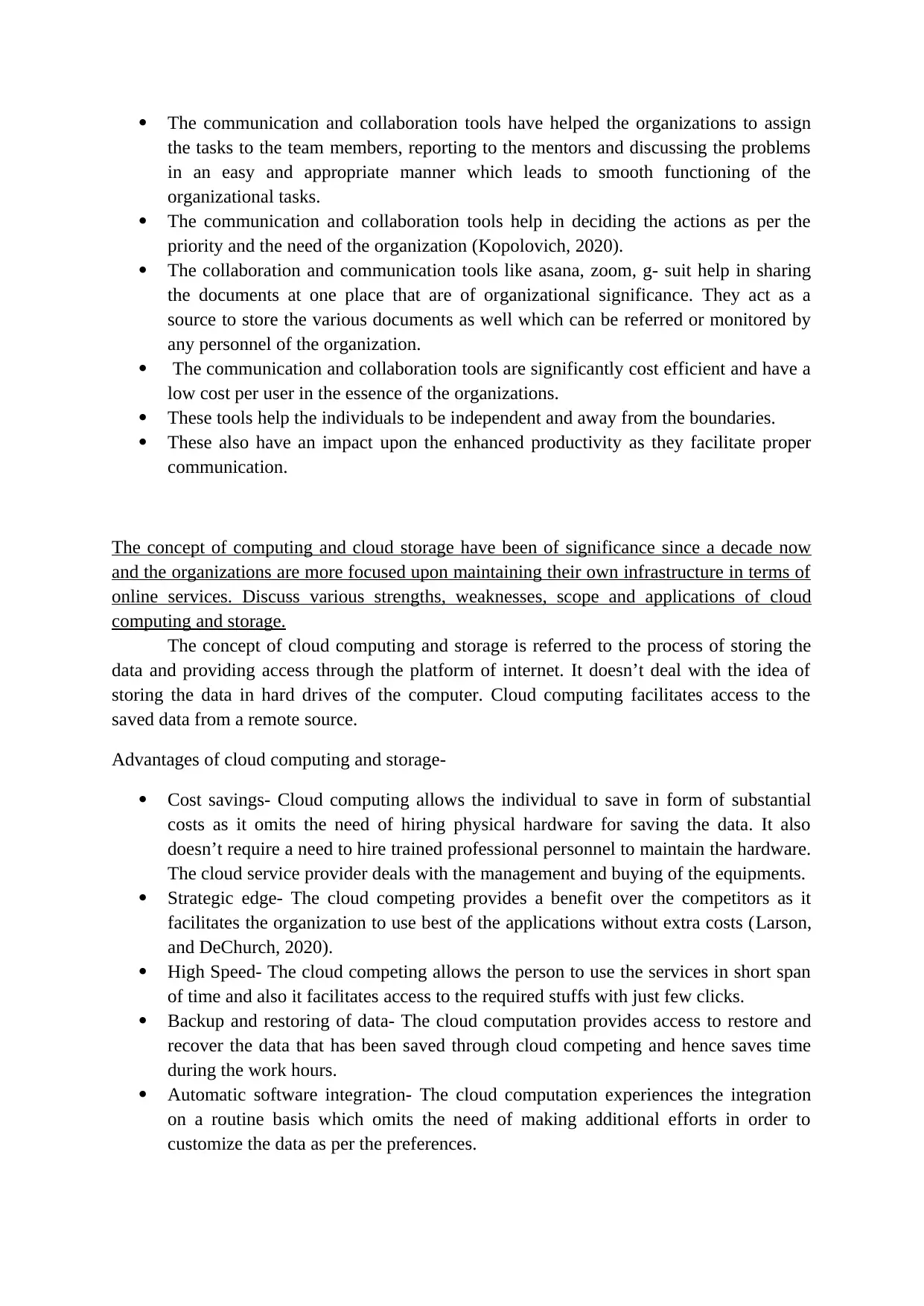
The communication and collaboration tools have helped the organizations to assign
the tasks to the team members, reporting to the mentors and discussing the problems
in an easy and appropriate manner which leads to smooth functioning of the
organizational tasks.
The communication and collaboration tools help in deciding the actions as per the
priority and the need of the organization (Kopolovich, 2020).
The collaboration and communication tools like asana, zoom, g- suit help in sharing
the documents at one place that are of organizational significance. They act as a
source to store the various documents as well which can be referred or monitored by
any personnel of the organization.
The communication and collaboration tools are significantly cost efficient and have a
low cost per user in the essence of the organizations.
These tools help the individuals to be independent and away from the boundaries.
These also have an impact upon the enhanced productivity as they facilitate proper
communication.
The concept of computing and cloud storage have been of significance since a decade now
and the organizations are more focused upon maintaining their own infrastructure in terms of
online services. Discuss various strengths, weaknesses, scope and applications of cloud
computing and storage.
The concept of cloud computing and storage is referred to the process of storing the
data and providing access through the platform of internet. It doesn’t deal with the idea of
storing the data in hard drives of the computer. Cloud computing facilitates access to the
saved data from a remote source.
Advantages of cloud computing and storage-
Cost savings- Cloud computing allows the individual to save in form of substantial
costs as it omits the need of hiring physical hardware for saving the data. It also
doesn’t require a need to hire trained professional personnel to maintain the hardware.
The cloud service provider deals with the management and buying of the equipments.
Strategic edge- The cloud competing provides a benefit over the competitors as it
facilitates the organization to use best of the applications without extra costs (Larson,
and DeChurch, 2020).
High Speed- The cloud competing allows the person to use the services in short span
of time and also it facilitates access to the required stuffs with just few clicks.
Backup and restoring of data- The cloud computation provides access to restore and
recover the data that has been saved through cloud competing and hence saves time
during the work hours.
Automatic software integration- The cloud computation experiences the integration
on a routine basis which omits the need of making additional efforts in order to
customize the data as per the preferences.
the tasks to the team members, reporting to the mentors and discussing the problems
in an easy and appropriate manner which leads to smooth functioning of the
organizational tasks.
The communication and collaboration tools help in deciding the actions as per the
priority and the need of the organization (Kopolovich, 2020).
The collaboration and communication tools like asana, zoom, g- suit help in sharing
the documents at one place that are of organizational significance. They act as a
source to store the various documents as well which can be referred or monitored by
any personnel of the organization.
The communication and collaboration tools are significantly cost efficient and have a
low cost per user in the essence of the organizations.
These tools help the individuals to be independent and away from the boundaries.
These also have an impact upon the enhanced productivity as they facilitate proper
communication.
The concept of computing and cloud storage have been of significance since a decade now
and the organizations are more focused upon maintaining their own infrastructure in terms of
online services. Discuss various strengths, weaknesses, scope and applications of cloud
computing and storage.
The concept of cloud computing and storage is referred to the process of storing the
data and providing access through the platform of internet. It doesn’t deal with the idea of
storing the data in hard drives of the computer. Cloud computing facilitates access to the
saved data from a remote source.
Advantages of cloud computing and storage-
Cost savings- Cloud computing allows the individual to save in form of substantial
costs as it omits the need of hiring physical hardware for saving the data. It also
doesn’t require a need to hire trained professional personnel to maintain the hardware.
The cloud service provider deals with the management and buying of the equipments.
Strategic edge- The cloud competing provides a benefit over the competitors as it
facilitates the organization to use best of the applications without extra costs (Larson,
and DeChurch, 2020).
High Speed- The cloud competing allows the person to use the services in short span
of time and also it facilitates access to the required stuffs with just few clicks.
Backup and restoring of data- The cloud computation provides access to restore and
recover the data that has been saved through cloud competing and hence saves time
during the work hours.
Automatic software integration- The cloud computation experiences the integration
on a routine basis which omits the need of making additional efforts in order to
customize the data as per the preferences.
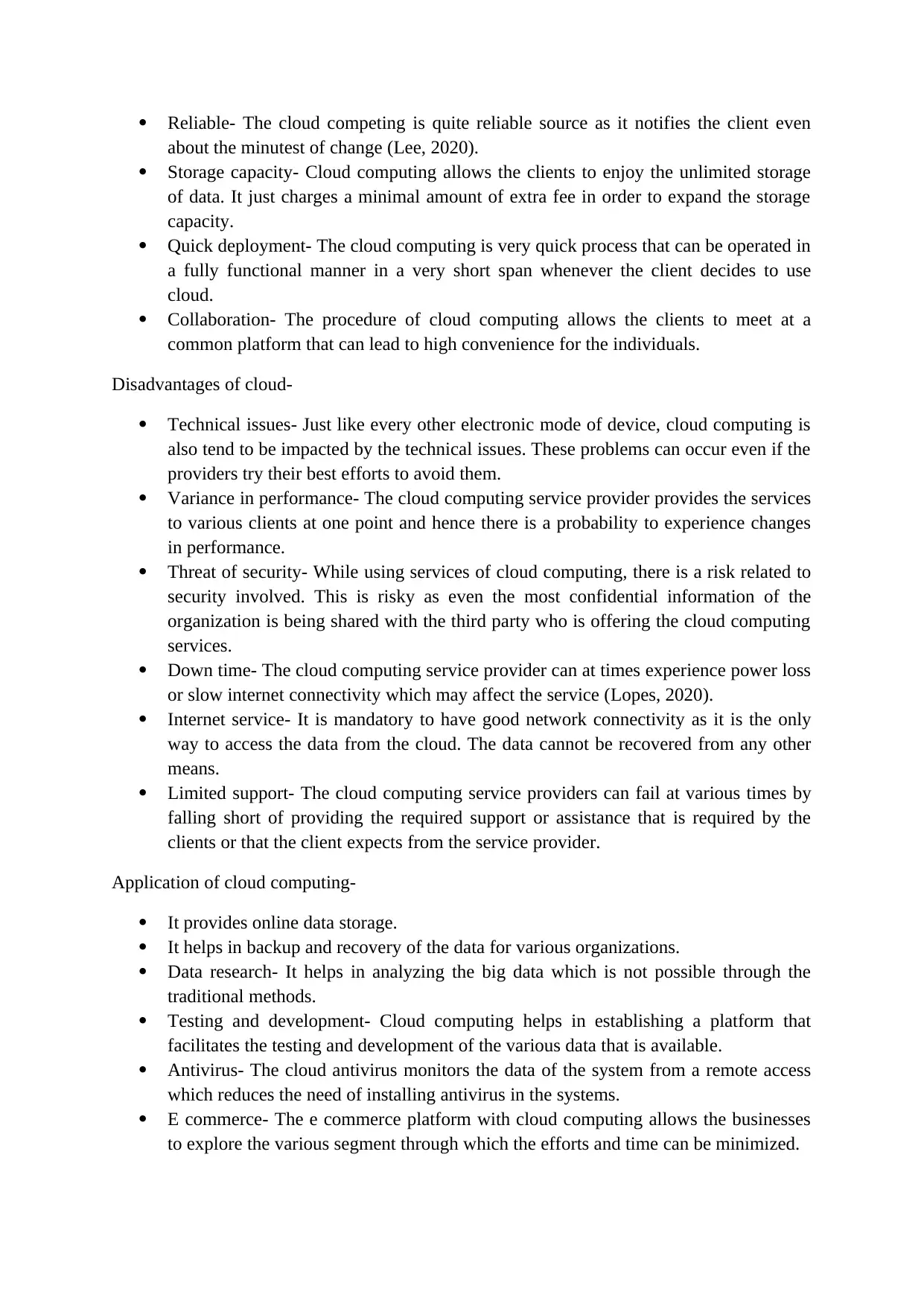
Reliable- The cloud competing is quite reliable source as it notifies the client even
about the minutest of change (Lee, 2020).
Storage capacity- Cloud computing allows the clients to enjoy the unlimited storage
of data. It just charges a minimal amount of extra fee in order to expand the storage
capacity.
Quick deployment- The cloud computing is very quick process that can be operated in
a fully functional manner in a very short span whenever the client decides to use
cloud.
Collaboration- The procedure of cloud computing allows the clients to meet at a
common platform that can lead to high convenience for the individuals.
Disadvantages of cloud-
Technical issues- Just like every other electronic mode of device, cloud computing is
also tend to be impacted by the technical issues. These problems can occur even if the
providers try their best efforts to avoid them.
Variance in performance- The cloud computing service provider provides the services
to various clients at one point and hence there is a probability to experience changes
in performance.
Threat of security- While using services of cloud computing, there is a risk related to
security involved. This is risky as even the most confidential information of the
organization is being shared with the third party who is offering the cloud computing
services.
Down time- The cloud computing service provider can at times experience power loss
or slow internet connectivity which may affect the service (Lopes, 2020).
Internet service- It is mandatory to have good network connectivity as it is the only
way to access the data from the cloud. The data cannot be recovered from any other
means.
Limited support- The cloud computing service providers can fail at various times by
falling short of providing the required support or assistance that is required by the
clients or that the client expects from the service provider.
Application of cloud computing-
It provides online data storage.
It helps in backup and recovery of the data for various organizations.
Data research- It helps in analyzing the big data which is not possible through the
traditional methods.
Testing and development- Cloud computing helps in establishing a platform that
facilitates the testing and development of the various data that is available.
Antivirus- The cloud antivirus monitors the data of the system from a remote access
which reduces the need of installing antivirus in the systems.
E commerce- The e commerce platform with cloud computing allows the businesses
to explore the various segment through which the efforts and time can be minimized.
about the minutest of change (Lee, 2020).
Storage capacity- Cloud computing allows the clients to enjoy the unlimited storage
of data. It just charges a minimal amount of extra fee in order to expand the storage
capacity.
Quick deployment- The cloud computing is very quick process that can be operated in
a fully functional manner in a very short span whenever the client decides to use
cloud.
Collaboration- The procedure of cloud computing allows the clients to meet at a
common platform that can lead to high convenience for the individuals.
Disadvantages of cloud-
Technical issues- Just like every other electronic mode of device, cloud computing is
also tend to be impacted by the technical issues. These problems can occur even if the
providers try their best efforts to avoid them.
Variance in performance- The cloud computing service provider provides the services
to various clients at one point and hence there is a probability to experience changes
in performance.
Threat of security- While using services of cloud computing, there is a risk related to
security involved. This is risky as even the most confidential information of the
organization is being shared with the third party who is offering the cloud computing
services.
Down time- The cloud computing service provider can at times experience power loss
or slow internet connectivity which may affect the service (Lopes, 2020).
Internet service- It is mandatory to have good network connectivity as it is the only
way to access the data from the cloud. The data cannot be recovered from any other
means.
Limited support- The cloud computing service providers can fail at various times by
falling short of providing the required support or assistance that is required by the
clients or that the client expects from the service provider.
Application of cloud computing-
It provides online data storage.
It helps in backup and recovery of the data for various organizations.
Data research- It helps in analyzing the big data which is not possible through the
traditional methods.
Testing and development- Cloud computing helps in establishing a platform that
facilitates the testing and development of the various data that is available.
Antivirus- The cloud antivirus monitors the data of the system from a remote access
which reduces the need of installing antivirus in the systems.
E commerce- The e commerce platform with cloud computing allows the businesses
to explore the various segment through which the efforts and time can be minimized.
⊘ This is a preview!⊘
Do you want full access?
Subscribe today to unlock all pages.

Trusted by 1+ million students worldwide
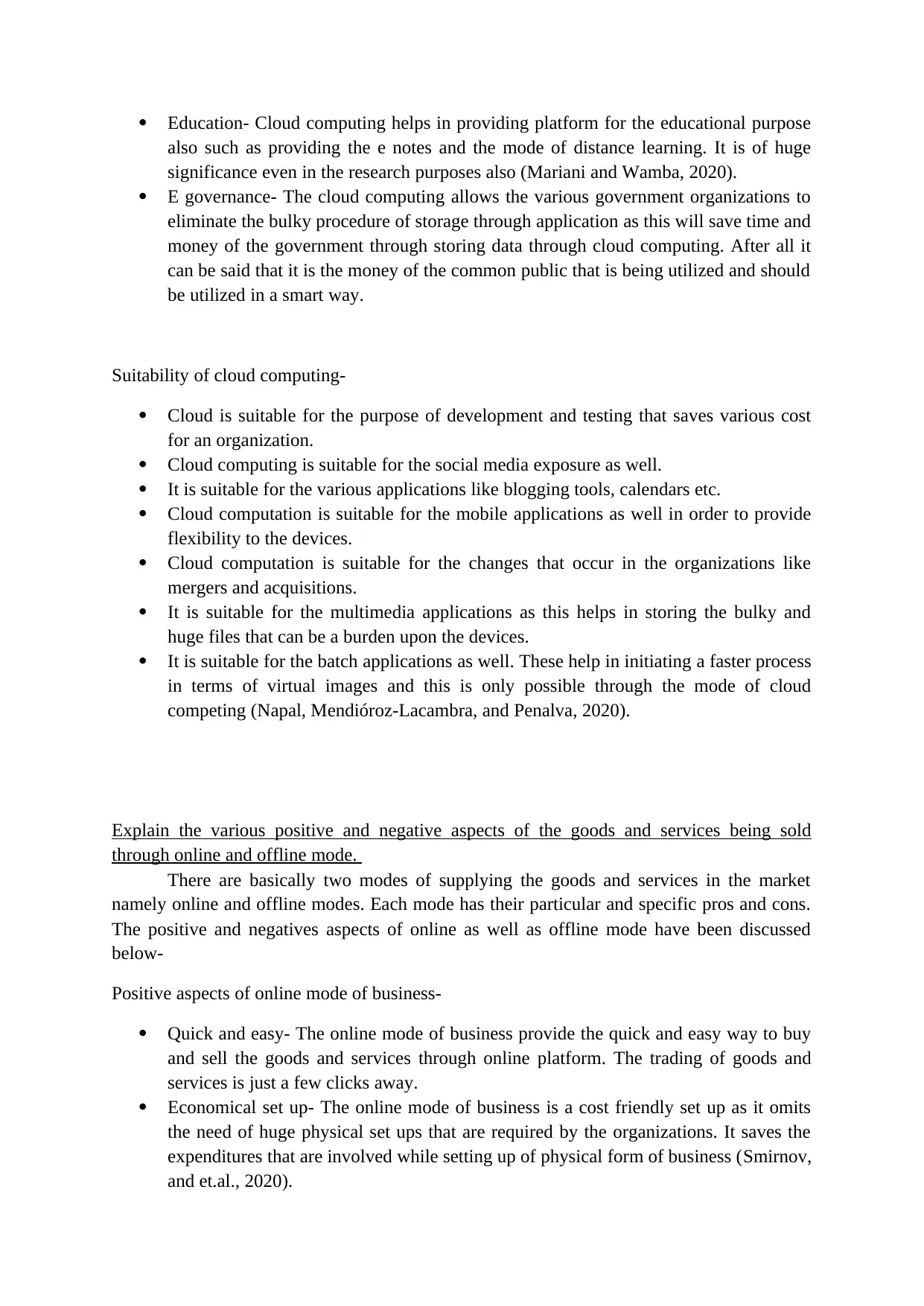
Education- Cloud computing helps in providing platform for the educational purpose
also such as providing the e notes and the mode of distance learning. It is of huge
significance even in the research purposes also (Mariani and Wamba, 2020).
E governance- The cloud computing allows the various government organizations to
eliminate the bulky procedure of storage through application as this will save time and
money of the government through storing data through cloud computing. After all it
can be said that it is the money of the common public that is being utilized and should
be utilized in a smart way.
Suitability of cloud computing-
Cloud is suitable for the purpose of development and testing that saves various cost
for an organization.
Cloud computing is suitable for the social media exposure as well.
It is suitable for the various applications like blogging tools, calendars etc.
Cloud computation is suitable for the mobile applications as well in order to provide
flexibility to the devices.
Cloud computation is suitable for the changes that occur in the organizations like
mergers and acquisitions.
It is suitable for the multimedia applications as this helps in storing the bulky and
huge files that can be a burden upon the devices.
It is suitable for the batch applications as well. These help in initiating a faster process
in terms of virtual images and this is only possible through the mode of cloud
competing (Napal, Mendióroz-Lacambra, and Penalva, 2020).
Explain the various positive and negative aspects of the goods and services being sold
through online and offline mode.
There are basically two modes of supplying the goods and services in the market
namely online and offline modes. Each mode has their particular and specific pros and cons.
The positive and negatives aspects of online as well as offline mode have been discussed
below-
Positive aspects of online mode of business-
Quick and easy- The online mode of business provide the quick and easy way to buy
and sell the goods and services through online platform. The trading of goods and
services is just a few clicks away.
Economical set up- The online mode of business is a cost friendly set up as it omits
the need of huge physical set ups that are required by the organizations. It saves the
expenditures that are involved while setting up of physical form of business (Smirnov,
and et.al., 2020).
also such as providing the e notes and the mode of distance learning. It is of huge
significance even in the research purposes also (Mariani and Wamba, 2020).
E governance- The cloud computing allows the various government organizations to
eliminate the bulky procedure of storage through application as this will save time and
money of the government through storing data through cloud computing. After all it
can be said that it is the money of the common public that is being utilized and should
be utilized in a smart way.
Suitability of cloud computing-
Cloud is suitable for the purpose of development and testing that saves various cost
for an organization.
Cloud computing is suitable for the social media exposure as well.
It is suitable for the various applications like blogging tools, calendars etc.
Cloud computation is suitable for the mobile applications as well in order to provide
flexibility to the devices.
Cloud computation is suitable for the changes that occur in the organizations like
mergers and acquisitions.
It is suitable for the multimedia applications as this helps in storing the bulky and
huge files that can be a burden upon the devices.
It is suitable for the batch applications as well. These help in initiating a faster process
in terms of virtual images and this is only possible through the mode of cloud
competing (Napal, Mendióroz-Lacambra, and Penalva, 2020).
Explain the various positive and negative aspects of the goods and services being sold
through online and offline mode.
There are basically two modes of supplying the goods and services in the market
namely online and offline modes. Each mode has their particular and specific pros and cons.
The positive and negatives aspects of online as well as offline mode have been discussed
below-
Positive aspects of online mode of business-
Quick and easy- The online mode of business provide the quick and easy way to buy
and sell the goods and services through online platform. The trading of goods and
services is just a few clicks away.
Economical set up- The online mode of business is a cost friendly set up as it omits
the need of huge physical set ups that are required by the organizations. It saves the
expenditures that are involved while setting up of physical form of business (Smirnov,
and et.al., 2020).
Paraphrase This Document
Need a fresh take? Get an instant paraphrase of this document with our AI Paraphraser
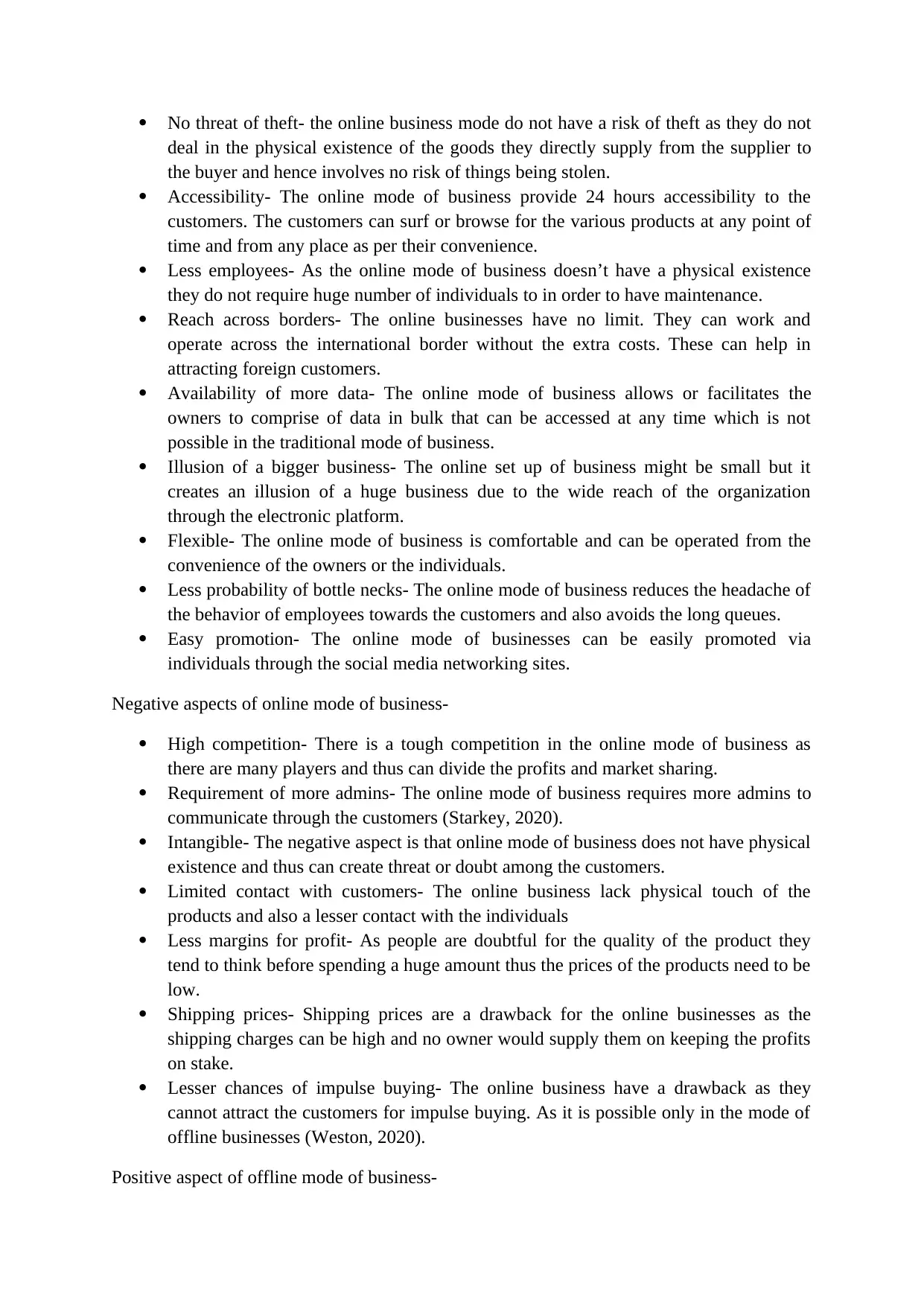
No threat of theft- the online business mode do not have a risk of theft as they do not
deal in the physical existence of the goods they directly supply from the supplier to
the buyer and hence involves no risk of things being stolen.
Accessibility- The online mode of business provide 24 hours accessibility to the
customers. The customers can surf or browse for the various products at any point of
time and from any place as per their convenience.
Less employees- As the online mode of business doesn’t have a physical existence
they do not require huge number of individuals to in order to have maintenance.
Reach across borders- The online businesses have no limit. They can work and
operate across the international border without the extra costs. These can help in
attracting foreign customers.
Availability of more data- The online mode of business allows or facilitates the
owners to comprise of data in bulk that can be accessed at any time which is not
possible in the traditional mode of business.
Illusion of a bigger business- The online set up of business might be small but it
creates an illusion of a huge business due to the wide reach of the organization
through the electronic platform.
Flexible- The online mode of business is comfortable and can be operated from the
convenience of the owners or the individuals.
Less probability of bottle necks- The online mode of business reduces the headache of
the behavior of employees towards the customers and also avoids the long queues.
Easy promotion- The online mode of businesses can be easily promoted via
individuals through the social media networking sites.
Negative aspects of online mode of business-
High competition- There is a tough competition in the online mode of business as
there are many players and thus can divide the profits and market sharing.
Requirement of more admins- The online mode of business requires more admins to
communicate through the customers (Starkey, 2020).
Intangible- The negative aspect is that online mode of business does not have physical
existence and thus can create threat or doubt among the customers.
Limited contact with customers- The online business lack physical touch of the
products and also a lesser contact with the individuals
Less margins for profit- As people are doubtful for the quality of the product they
tend to think before spending a huge amount thus the prices of the products need to be
low.
Shipping prices- Shipping prices are a drawback for the online businesses as the
shipping charges can be high and no owner would supply them on keeping the profits
on stake.
Lesser chances of impulse buying- The online business have a drawback as they
cannot attract the customers for impulse buying. As it is possible only in the mode of
offline businesses (Weston, 2020).
Positive aspect of offline mode of business-
deal in the physical existence of the goods they directly supply from the supplier to
the buyer and hence involves no risk of things being stolen.
Accessibility- The online mode of business provide 24 hours accessibility to the
customers. The customers can surf or browse for the various products at any point of
time and from any place as per their convenience.
Less employees- As the online mode of business doesn’t have a physical existence
they do not require huge number of individuals to in order to have maintenance.
Reach across borders- The online businesses have no limit. They can work and
operate across the international border without the extra costs. These can help in
attracting foreign customers.
Availability of more data- The online mode of business allows or facilitates the
owners to comprise of data in bulk that can be accessed at any time which is not
possible in the traditional mode of business.
Illusion of a bigger business- The online set up of business might be small but it
creates an illusion of a huge business due to the wide reach of the organization
through the electronic platform.
Flexible- The online mode of business is comfortable and can be operated from the
convenience of the owners or the individuals.
Less probability of bottle necks- The online mode of business reduces the headache of
the behavior of employees towards the customers and also avoids the long queues.
Easy promotion- The online mode of businesses can be easily promoted via
individuals through the social media networking sites.
Negative aspects of online mode of business-
High competition- There is a tough competition in the online mode of business as
there are many players and thus can divide the profits and market sharing.
Requirement of more admins- The online mode of business requires more admins to
communicate through the customers (Starkey, 2020).
Intangible- The negative aspect is that online mode of business does not have physical
existence and thus can create threat or doubt among the customers.
Limited contact with customers- The online business lack physical touch of the
products and also a lesser contact with the individuals
Less margins for profit- As people are doubtful for the quality of the product they
tend to think before spending a huge amount thus the prices of the products need to be
low.
Shipping prices- Shipping prices are a drawback for the online businesses as the
shipping charges can be high and no owner would supply them on keeping the profits
on stake.
Lesser chances of impulse buying- The online business have a drawback as they
cannot attract the customers for impulse buying. As it is possible only in the mode of
offline businesses (Weston, 2020).
Positive aspect of offline mode of business-
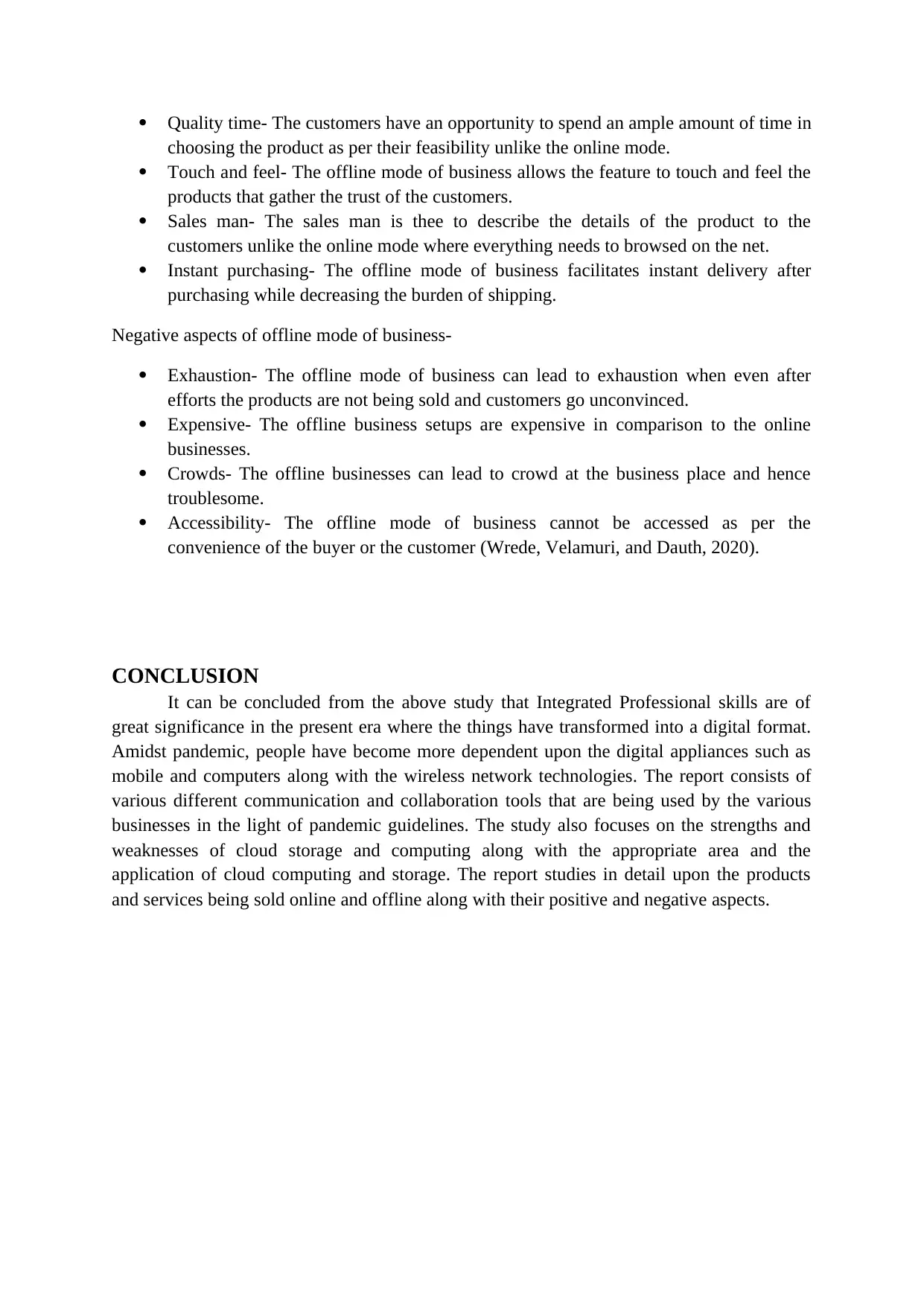
Quality time- The customers have an opportunity to spend an ample amount of time in
choosing the product as per their feasibility unlike the online mode.
Touch and feel- The offline mode of business allows the feature to touch and feel the
products that gather the trust of the customers.
Sales man- The sales man is thee to describe the details of the product to the
customers unlike the online mode where everything needs to browsed on the net.
Instant purchasing- The offline mode of business facilitates instant delivery after
purchasing while decreasing the burden of shipping.
Negative aspects of offline mode of business-
Exhaustion- The offline mode of business can lead to exhaustion when even after
efforts the products are not being sold and customers go unconvinced.
Expensive- The offline business setups are expensive in comparison to the online
businesses.
Crowds- The offline businesses can lead to crowd at the business place and hence
troublesome.
Accessibility- The offline mode of business cannot be accessed as per the
convenience of the buyer or the customer (Wrede, Velamuri, and Dauth, 2020).
CONCLUSION
It can be concluded from the above study that Integrated Professional skills are of
great significance in the present era where the things have transformed into a digital format.
Amidst pandemic, people have become more dependent upon the digital appliances such as
mobile and computers along with the wireless network technologies. The report consists of
various different communication and collaboration tools that are being used by the various
businesses in the light of pandemic guidelines. The study also focuses on the strengths and
weaknesses of cloud storage and computing along with the appropriate area and the
application of cloud computing and storage. The report studies in detail upon the products
and services being sold online and offline along with their positive and negative aspects.
choosing the product as per their feasibility unlike the online mode.
Touch and feel- The offline mode of business allows the feature to touch and feel the
products that gather the trust of the customers.
Sales man- The sales man is thee to describe the details of the product to the
customers unlike the online mode where everything needs to browsed on the net.
Instant purchasing- The offline mode of business facilitates instant delivery after
purchasing while decreasing the burden of shipping.
Negative aspects of offline mode of business-
Exhaustion- The offline mode of business can lead to exhaustion when even after
efforts the products are not being sold and customers go unconvinced.
Expensive- The offline business setups are expensive in comparison to the online
businesses.
Crowds- The offline businesses can lead to crowd at the business place and hence
troublesome.
Accessibility- The offline mode of business cannot be accessed as per the
convenience of the buyer or the customer (Wrede, Velamuri, and Dauth, 2020).
CONCLUSION
It can be concluded from the above study that Integrated Professional skills are of
great significance in the present era where the things have transformed into a digital format.
Amidst pandemic, people have become more dependent upon the digital appliances such as
mobile and computers along with the wireless network technologies. The report consists of
various different communication and collaboration tools that are being used by the various
businesses in the light of pandemic guidelines. The study also focuses on the strengths and
weaknesses of cloud storage and computing along with the appropriate area and the
application of cloud computing and storage. The report studies in detail upon the products
and services being sold online and offline along with their positive and negative aspects.
⊘ This is a preview!⊘
Do you want full access?
Subscribe today to unlock all pages.

Trusted by 1+ million students worldwide
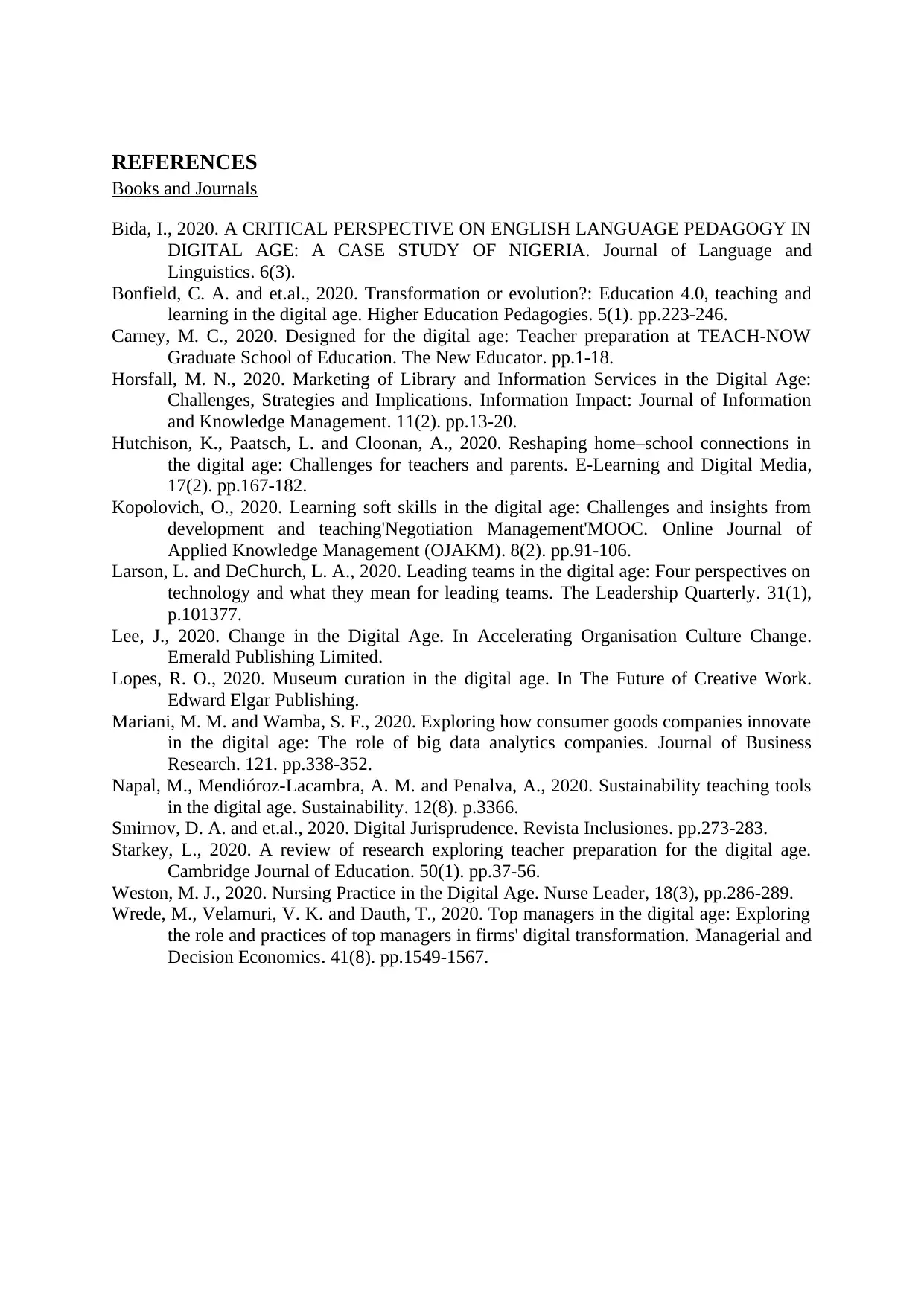
REFERENCES
Books and Journals
Bida, I., 2020. A CRITICAL PERSPECTIVE ON ENGLISH LANGUAGE PEDAGOGY IN
DIGITAL AGE: A CASE STUDY OF NIGERIA. Journal of Language and
Linguistics. 6(3).
Bonfield, C. A. and et.al., 2020. Transformation or evolution?: Education 4.0, teaching and
learning in the digital age. Higher Education Pedagogies. 5(1). pp.223-246.
Carney, M. C., 2020. Designed for the digital age: Teacher preparation at TEACH-NOW
Graduate School of Education. The New Educator. pp.1-18.
Horsfall, M. N., 2020. Marketing of Library and Information Services in the Digital Age:
Challenges, Strategies and Implications. Information Impact: Journal of Information
and Knowledge Management. 11(2). pp.13-20.
Hutchison, K., Paatsch, L. and Cloonan, A., 2020. Reshaping home–school connections in
the digital age: Challenges for teachers and parents. E-Learning and Digital Media,
17(2). pp.167-182.
Kopolovich, O., 2020. Learning soft skills in the digital age: Challenges and insights from
development and teaching'Negotiation Management'MOOC. Online Journal of
Applied Knowledge Management (OJAKM). 8(2). pp.91-106.
Larson, L. and DeChurch, L. A., 2020. Leading teams in the digital age: Four perspectives on
technology and what they mean for leading teams. The Leadership Quarterly. 31(1),
p.101377.
Lee, J., 2020. Change in the Digital Age. In Accelerating Organisation Culture Change.
Emerald Publishing Limited.
Lopes, R. O., 2020. Museum curation in the digital age. In The Future of Creative Work.
Edward Elgar Publishing.
Mariani, M. M. and Wamba, S. F., 2020. Exploring how consumer goods companies innovate
in the digital age: The role of big data analytics companies. Journal of Business
Research. 121. pp.338-352.
Napal, M., Mendióroz-Lacambra, A. M. and Penalva, A., 2020. Sustainability teaching tools
in the digital age. Sustainability. 12(8). p.3366.
Smirnov, D. A. and et.al., 2020. Digital Jurisprudence. Revista Inclusiones. pp.273-283.
Starkey, L., 2020. A review of research exploring teacher preparation for the digital age.
Cambridge Journal of Education. 50(1). pp.37-56.
Weston, M. J., 2020. Nursing Practice in the Digital Age. Nurse Leader, 18(3), pp.286-289.
Wrede, M., Velamuri, V. K. and Dauth, T., 2020. Top managers in the digital age: Exploring
the role and practices of top managers in firms' digital transformation. Managerial and
Decision Economics. 41(8). pp.1549-1567.
Books and Journals
Bida, I., 2020. A CRITICAL PERSPECTIVE ON ENGLISH LANGUAGE PEDAGOGY IN
DIGITAL AGE: A CASE STUDY OF NIGERIA. Journal of Language and
Linguistics. 6(3).
Bonfield, C. A. and et.al., 2020. Transformation or evolution?: Education 4.0, teaching and
learning in the digital age. Higher Education Pedagogies. 5(1). pp.223-246.
Carney, M. C., 2020. Designed for the digital age: Teacher preparation at TEACH-NOW
Graduate School of Education. The New Educator. pp.1-18.
Horsfall, M. N., 2020. Marketing of Library and Information Services in the Digital Age:
Challenges, Strategies and Implications. Information Impact: Journal of Information
and Knowledge Management. 11(2). pp.13-20.
Hutchison, K., Paatsch, L. and Cloonan, A., 2020. Reshaping home–school connections in
the digital age: Challenges for teachers and parents. E-Learning and Digital Media,
17(2). pp.167-182.
Kopolovich, O., 2020. Learning soft skills in the digital age: Challenges and insights from
development and teaching'Negotiation Management'MOOC. Online Journal of
Applied Knowledge Management (OJAKM). 8(2). pp.91-106.
Larson, L. and DeChurch, L. A., 2020. Leading teams in the digital age: Four perspectives on
technology and what they mean for leading teams. The Leadership Quarterly. 31(1),
p.101377.
Lee, J., 2020. Change in the Digital Age. In Accelerating Organisation Culture Change.
Emerald Publishing Limited.
Lopes, R. O., 2020. Museum curation in the digital age. In The Future of Creative Work.
Edward Elgar Publishing.
Mariani, M. M. and Wamba, S. F., 2020. Exploring how consumer goods companies innovate
in the digital age: The role of big data analytics companies. Journal of Business
Research. 121. pp.338-352.
Napal, M., Mendióroz-Lacambra, A. M. and Penalva, A., 2020. Sustainability teaching tools
in the digital age. Sustainability. 12(8). p.3366.
Smirnov, D. A. and et.al., 2020. Digital Jurisprudence. Revista Inclusiones. pp.273-283.
Starkey, L., 2020. A review of research exploring teacher preparation for the digital age.
Cambridge Journal of Education. 50(1). pp.37-56.
Weston, M. J., 2020. Nursing Practice in the Digital Age. Nurse Leader, 18(3), pp.286-289.
Wrede, M., Velamuri, V. K. and Dauth, T., 2020. Top managers in the digital age: Exploring
the role and practices of top managers in firms' digital transformation. Managerial and
Decision Economics. 41(8). pp.1549-1567.
1 out of 10
Related Documents
Your All-in-One AI-Powered Toolkit for Academic Success.
+13062052269
info@desklib.com
Available 24*7 on WhatsApp / Email
![[object Object]](/_next/static/media/star-bottom.7253800d.svg)
Unlock your academic potential
Copyright © 2020–2025 A2Z Services. All Rights Reserved. Developed and managed by ZUCOL.



